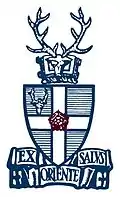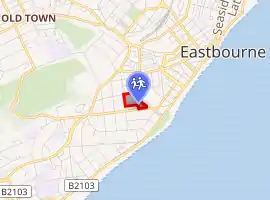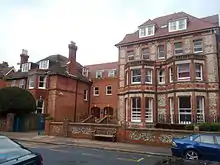Eastbourne College
Eastbourne College is a mildly selective co-educational independent school in the British public school tradition, for day and boarding pupils aged 13–18, in the town of Eastbourne on the south coast of England. The College's headmaster is Tom Lawson.
| College | |
|---|---|
 | |
| Address | |

| |
Old Wish Road , , BN21 4JY England | |
| Coordinates | 50.7627°N 0.2811°E |
| Information | |
| Type | Public school Independent day and boarding |
| Motto | Ex Oriente Salus ("The haven [the bourne] from the East") |
| Religious affiliation(s) | Church of England |
| Established | 1867 |
| Founders | 7th Duke of Devonshire and other prominent Eastbourne citizens |
| Local authority | East Sussex County Council |
| Department for Education URN | 114650 Tables |
| Ofsted | Reports |
| President | The Duke of Devonshire |
| Chairman of the College Council | Philip Broadley MA (Oxon) MSc FCA [1] |
| Headmaster | Tom Lawson MA (Oxon) |
| Chaplain | Reverend Daniel Merceron |
| Staff | 236~ |
| Gender | Co-educational |
| Age | 13 to 18 |
| Enrolment | 630~ |
| Houses | 5 day, 5 boarding |
| Colour(s) | Maroon White Crimson |
| Mascot | Stag |
| Publication | The Eastbournian The Old Eastbournian |
| Former pupils | Old Eastbournians |
| Website | eastbourne-college |
Overview
The College was founded by the Duke of Devonshire and other prominent Eastbourne citizens in 1867.
The College is in the Lower Meads area of Eastbourne, in a mainly residential area. Most of the school buildings are on a central campus area but many others are scattered in the immediate vicinity, such as the Beresford hockey and the links rugby pitches.
The motto, Ex Oriente Salus, is a play on "Eastbourne", meaning "The haven[the bourne]from the East". Salus also means health.
History
Dr Charles Hayman, an Eastbourne medical practitioner and member of the town's first Council, together with other prominent local citizens, decided an independent school 'for the education of the sons of noblemen and gentlefolk' should be established and the support of the 7th Duke of Devonshire was sought. The Duke was supportive of the venture and provided 12 acres (4.9 ha) of land for purchase at a modest price. This link with the Cavendish family is evidenced by the stag in the school emblem.
From 1867 to 1869 it occupied Ellesmere Villa, now called Spencer Court; the location is now marked by a blue plaque. Architect Henry Currey was assigned by the Duke to design a new school building, and College House, now School House, was built in 1870. The school chapel was constructed that same year.
During the 1880s, the school went through an impoverished period. Through the intervention of George Wallis, first mayor of Eastbourne and the work of new headmaster Rev Dr Charles Crowden, formerly of Cranbrook School, the school was saved from financial disaster.[2]
In 1967 Eastbourne College celebrated its centenary. Ex Oriente Salus - A Centenary History of Eastbourne College was published for the occasion and consists of a compilation by Vincent Mulcaster Allom, who spent over 30 years teaching at the school, of old photographs, news articles and illustrations of the school.
The college admitted its first girls in 1969 when the sixth form became coeducational and is now fully coeducational.
Recent developments
£33 million 'Project 150' development
On 21 June 2019, Dame Katherine Grainger MBE CBE DBE officially opened the Nugee and Winn buildings. The opening concluded the College's four-year journey to complete the award-winning project in time for its 150th anniversary. The development was sensitive to the local conservation area (building down and up instead of out) and delivered 20 years of development in just four years. The College received over 1,000 donations from its global network of former pupils, parents, and staff.
Project 150 facilities
- 32 new state-of-the-art classrooms
- two specialist IT suites
- a multi-level cricket pavilion
- a school shop
- several stunning entertaining areas
- a Sport England-compliant sports hall
- a six-lane Olympic standard 25m swimming pool with full Swiss touch-pad timing system
- two glass-backed squash courts
- a dance studio (with recess in ceiling for aerial techniques)
- a state-of-the-art fitness suite
- an alfresco-feel dining hall catering for 600 per sitting
- a pupil café
New timetable/shape of the week
In September 2019, Eastbourne College introduced a brand new seven-day timetable to better fit around the demands of modern family life. The traditional timetable, with its five-day week plus compulsory lessons on Saturday morning for all pupils (boarding and day), gave way to a more focused five-day week, with optional Saturday morning enrichment sessions. The requirement for pupils to wear week-day uniform on Saturday mornings was also dropped in favour of a more relaxed approach within the boundaries of an 'acceptable dress code' policy. A busy calendar of sports fixtures on Saturday afternoons remains a prominent feature and boarding pupils benefit from greater freedom when signing in and out of school at weekends. Overall, the changes to the shape of the week have created more educational contact time while broadening co-curricular provision, and given greater flexibility to both boarding and day pupils. The College made a film about its new weekends.
New uniform
In September 2020, the College introduced a new uniform for Years 9, 10 and 11 (sixth formers continue to wear business suits). The new uniform and mode of purchase (online) represented a sea change for the College.
The new look seeks to celebrate the College as a modern, connected school; mindful of the saying that ‘Eastbournians are good people that others want to be with.’ A more relaxed and sophisticated look (crisp, clean and classy), mindful of the concept of ‘blue health’ and the school’s motto ‘Ex Oriente Salus’ [health from the east]. Although more relaxed, the uniform also seeks to be gently stylish while remaining true to the College character; classic and timeless more than fashionable, respecting College values, tradition and heritage. It aims to be a little different and distinctive with references to the colours of the sea and the nearby South Downs, and connected to Eastbourne as a touristic seaside, and sporty/outdoors destination.


Boarding and day houses
- Boarding Houses
- Gonville (Boys)
- Nugent (Girls)
- Pennell (Boys)
- School (Girls)
- Wargrave (Boys)
- Day Houses
- Blackwater (Girls)
- Craig (Boys)
- Powell (Boys)
- Reeves (Boys)
- Watt (Girls)
Many of these houses were donated to the school in wills and named after their benefactors; for example, Powell was given to the college by Stanley Powell.
.jpg.webp)
Academics
Unlike many other schools and colleges, all Eastbourne College pupils sit gold-standard A-level or Cambridge Pre-U qualifications for all their subjects in the sixth form. The College also offers the popular and well-respected Extended Project Qualification (EPQ), the Gold Arts Award, and is working towards a Gold or Platinum Artsmark. The school believes that these qualifications represent the gold-standard for preparing sixth formers for higher education and the workplace. This approach also enables the teachers, pastoral staff, and other specialists in their field (eg elite professional sports coaches), to deliver a vast, tailor-made programme of additional academic and non-academic guided opportunities, instead of offering National Vocational Qualifications (NVQs), apprentiships and/or BTECs.
Exam Results
A-levels
In 2020, 55% of the grades awarded were A* or A, and the overall proportion of A*, A or B grades was a shade under 80%, representing a steady uptick in the School's results (and top grades) for the third year in a row. In the same year, 93% of grades awarded to scholars were A*-A.
GCSE
Over one in five (22%) GCSE grades awarded to Year 10 and 11 pupils were at the highest grade available, grade 9. Over 40% of grades were 9 or 8 (equivalent to A*). Top grades accounted for the vast majority of grades awarded, with almost two thirds of all grades being a 7, 8 or 9 (equivalent to A*-A). Over a quarter of all pupils taking GCSE achieved ten or more grades at 7, 8 or 9, and thirteen pupils received ten or more grades at 8 or 9. Almost 70% of pupils were awarded five or more grades at 7-9. The school also achieved close to a 100% pass rate with 99.8% of grades awarded 9-4.
Extracurricular activities
Combined Cadet Force
The school's CCF corps was founded in 1896.[2] Pupils in Year 10 are obligated to join, older years are encouraged to. The CCF has Royal Navy, Army and Royal Air Force sections for the pupils to choose from.
Sport
Sport is played at the many facilities around the college (including College Field which has been used for training by teams such as South Africa upon arrival in the UK and some internationals) and at various locations around the town acquired by the college. Former pupils who have achieved sporting success include rugby players Hugo Southwell (Scotland and London Wasps) and Mark Lock (Leeds Tykes) and cricket player Ed Giddins.
Each term at the college has a single primary sport:
| Term | Boys | Girls |
|---|---|---|
| Michaelmas | Rugby union | Hockey |
| Lent | Hockey | Netball |
| Summer | Cricket | Tennis |
There are also alternative sports, including football, cross country, swimming, golf, tennis, squash, rowing, sailing, rugby fives, Fives and rounders. The school owns a boat house nearby the campus.[3]
Chapel
The Chapel is within the 'central' tradition of the Church of England, and the College has a full-time Chaplain. Assembly takes place there on Mondays and Wednesdays. There are Sunday services throughout term time, and at the beginning and end of each term there is a whole school service in All Saints' Church, immediately adjacent to the school. There is a student-led College Christian Union which is attended by students of various Christian traditions. There is also a Bible study group (The Connection) led by two members of staff which meets weekly throughout the year.
Every year a confirmation service is held in the Chapel. The Chaplain prepares candidates for confirmation in the months preceding this service and this includes an awayday at Ashburnham Place.
The services on Speech Day, the Christmas Service of Nine Lessons and Carols and all other whole-school services of thanksgiving are held at St Saviour's, the College church.
The College's current chaplain is Reverend Daniel Merceron, a former Army Chaplain.
Links with Radley College
The Second World War saw the evacuation of Eastbourne College to Radley College, and the plaque with its generous inscription commemorating this move and referring to "sympathy... and easy comradeship" has long been a significant feature of the Radley's Chapel Cloister. The Warden at the time, J C Vaughan Wilkes, was a son of the proprietors of St Cyprian's prep school with which Eastbourne College long had close connections. After the war, the College acquired St Cyprian's playing fields and the Memorial Gates were installed at the entrance.
At the turn of the millennium the Arnold Embellishers, a society of friends of Eastbourne College, decided that there should be a similar memorial in Eastbourne itself, and on Sunday 23 June 2002, in a short ceremony introduced by Eastbourne's Headmaster, Charles Bush and Angus McPhail unveiled a plaque in their own Cloisters. The inscription reads "In memory of those who made it possible to survive the Second World War by taking us to Radley College and, when peace returned, bringing us safely home, under the leadership of the Headmaster Francis John Nugee MA". Many of the headmasters of Eastbourne College were Radley boys.
In celebration of the occasion, the Radley v Eastbourne cricket match was revived.
Birley Centre
On 17 October 2011, Gus Christie, chairman of the Glyndebourne Festival Opera, opened the Birley Centre.[4] It was named after Michael Birley, former Headmaster of Eastbourne College (1956-1970), and now has facilities such as a recording studio and a state of the art theatre space.
In popular culture
The Southern Railway made great use of steam locomotive names for publicity, and the carrying of pupils to boarding schools at the beginning and end of school terms was a significant traffic flow.[5] Locomotives of the 'V' or "Schools" Class, introduced in 1930, were hence named after prominent English public schools. The fifteenth locomotive, no. 914, was named Eastbourne after the college. Built at Eastleigh in October 1932, no. 914 remained in service until withdrawn by British Railways in July 1961.[6]
Notable Old Eastbournians
Former pupils
Former pupils are known as "Old Eastbournians" and are members of the Old Eastbournian Association.
- Nick Atkinson, lead singer of the band Rooster
- Harry Bentley, jockey
- Olav Bjortomt, World Quiz Champion 2003, writes quizzes in The Times newspaper
- Sir Hugh Casson, architect
- Aleister Crowley, occultist and mystic
- Michael Fish, weather forecaster
- Richard Fitter, naturalist
- Ed Giddins, cricketer
- Charles Hedley, naturalist
- Bob Holness, presenter
- David Howell, chess Grandmaster
- Eddie Izzard, comedian
- Nasser Judeh, Jordanian former Minister of Foreign Affairs.
- Sam Kiley, security editor of Sky News
- Jules Knight, actor and singer
- Timothy Landon, brigadier
- Oliver W F Lodge, poet and author
- Ruari McLean, designer
- Ian Mortimer, historian and historical biographer
- Adam Mynott, BBC journalist[7]
- Michael Praed, actor
- Charles Rivett-Carnac, Commissioner of Royal Canadian Mounted Police
- David Smith, historian and Fellow of Selwyn College, Cambridge
- Frederick Soddy, chemist and Nobel laureate
- Sirichok Sopha, Thai politician
- Hugo Southwell, rugby player
- Ed Speleers, actor, played Eragon in the Inheritance Cycle and footman Jimmy in the ITV drama Downton Abbey
- Gwilym Lloyd George, 1st Viscount Tenby, politician
- William Lloyd George, 3rd Viscount Tenby
- John Wells, satirist, co-author of the Dear Bill column in Private Eye
- Woodrow Lyle Wyatt, Baron Wyatt of Weeford, politician, journalist and diarist
- Royce Mills, actor
- John Young, cricketer[8]
- James Yuill, folktronica musician
- Theodore Leighton Pennell, missionary and eccentric
- Alex Simcox, cricketer
- Hugh Skinner, actor
- Guy McKnight, singer/songwriter
- W. P. D. Wightman philosophical author
- Professor Peter Wildy, virologist
- Thomas Wilson, cricketer
Military
- Wing Commander Roland Beamont, British fighter pilot[9]
- Admiral Sir Ian Forbes, former Deputy Supreme Allied Commander Atlantic.
- Brigadier Timothy Landon, moderniser of the Sultanate of Oman
- Major-general Hugh Prince, Chief of the Military Planning Office of the Southeast Asia Treaty Organization
- General Sir David Richards, Chief of the Defence Staff
- Major General Patrick Kay, Chief of Staff of the Royal Marines and Secretary of the Defence, Press and Broadcasting Advisory Committee
Victoria Cross holders
Two Old Eastbournians have won the Victoria Cross:[10]
- Tirah Campaign, India
- Captain Henry Singleton Pennell VC. He was a Lieutenant when he performed the act for which he received the VC.
- First World War
- Group Captain Lionel Wilmot Brabazon Rees VC OBE MC AFC RAF. He was a Major when he performed the act for which he received the VC.
Military Cross holders
- Second World War
See also
Notes
- College Archives
- Allom, Vincent Mulcaster; Eastbourne College (1967). Ex Oriente Salus - A Centenary History of Eastbourne College. ISBN 978-0950355900.
References
- http://www.eastbourne-college.co.uk/Board-of-Governors
- "College Timeline". Archived from the original on 17 February 2012. Retrieved 29 May 2012.
- "Eastbourne College BC". British Rowing.
- "Birley Centre cements college links with town". Eastbourne Herald. 17 October 2011.
- "Maunsell V 'Schools' class 4-4-0". Southern E-Group. 19 June 2008. Retrieved 24 June 2009.
- "Maunsell V 'Schools' class 4-4-0 - Data". Southern E-Group. 10 February 2008. Retrieved 24 June 2009.
- "Adam Mynott". BBC News. 12 July 2004. Retrieved 1 May 2010.
- "Player profile: John Young". CricketArchive. Retrieved 11 December 2011.
- Roland Beamont#cite note-0
- Webster F.A.M., (1937), Our Great Public Schools, (Butler & Tanner: London)
Bibliography
External links
- School website
- Eastbourne College Society
- Profile on the Good Schools Guide
- ISI Inspection Reports
- Ofsted Social Care Inspection Reports